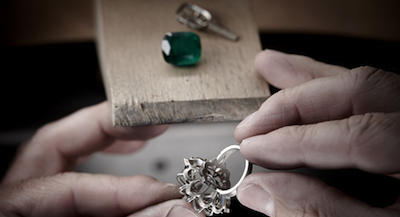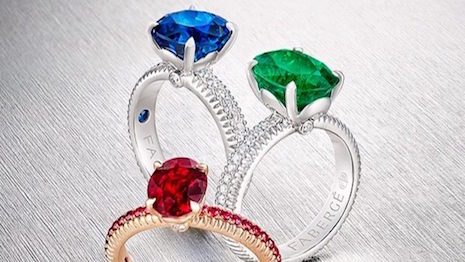Consumer sentiment for colored-gemstones such as rubies, emeralds and sapphires is on the rise, particularly with millennials, according to research by colored-gemstone miner Gemfields.
Founded in 2004, London-based Gemfields is the world’s leading supplier of responsibly sourced colored-gemstones including rubies, emeralds and amethysts. As a supplier, Gemfields provides colored-stones to international jewelers such as Chopard and Bulgari, and is the outright owner of Fabergé, dealings that place the brand at the epicenter of its market.
“There has been growing interest in colored stones amongst the most influential jewelry designers, and this is now beginning to hit the mainstream and become a legitimate trend across all price points,” said Sally Morrison, director of sales and marketing for Gemfields US.
“Fashion and the editorial community have been hungry for new options, and color has stepped in to meet that need,” she said. “Access to stones is also a contributing factor.
“With companies such as Gemfields becoming a trusted source of consistent, quality, responsibly sourced stones, designers have the ability to create more and consumers can buy with confidence.”
Color by gemstone
Gemfields has based its business of the practice of “mine to market” traceability. Gemfields operates, owns or holds interest and licenses in mines in Zambia, Mozambique, Colombia and Sri Lanka among others, allowing jewelers to know the source of the stones used in their designs.
Mine to market traceability also appeals to the increasingly conscious consumer who has in many cases steered away from diamonds due to the stone’s murky origins. To this point, Gemfields’ transparency, as well as that of its brand partners, has played a role in the resurgence of the colored-gemstone market.
For example, Swiss jeweler Chopard uses only emeralds sourced by Gemfields in is jewelry. The pieces will also be validated by Eco-Age’s Green Carpet Challenge (GCC) Principles of Sustainable Excellence (see story).

Chopard ring with a Gemfields emerald
“Gemfields has been a leader in fueling this trend by fostering emerging design talent and developing programs that help them create with color,” Ms. Morrison said. “The company has also stepped up to become a dependable source of colored-stones for the leading jewelry houses, ensuring they have access to supply at all size and quality levels.
“Gemfields has focused major resources behind educating and inspiring consumers on the exciting world of colored gemstones,” she said.
In its report, conducted in the United States this September, Gemfields sought to examine interest to understand the potential of colored-gemstone jewelry. Gemfields surveyed approximately 4,000 consumers, ages 21 to 64, who have purchased or received colored-gemstone jewelry within the last two years.
Despite limited marketing and brand awareness, Gemfields found that colored-gemstones are “enjoy[ing] considerable popularity” in the U.S. market. Thirty-one percent of female consumers surveyed purchased or received jewelry containing a ruby, emerald or sapphire since 2014.
Among millennials this finding is higher, with four in 10, or 41 percent, having acquired a colored-gemstone jewelry piece in the last 24 months. Millennials also rely heavily on social media and mobile devices to research colored-gemstone jewelry.
Jewelry that includes colored-gemstones is also worn often, with 43 percent of women surveyed saying they wear their rubies, emeralds or sapphires on a daily basis. Twenty-four percent expressed wearing colored-gemstones at least once a week while only 7 percent limit wearing their pieces for special occasions.

Fabergé’s #SayYesInColour campaign
Gemfields’ research also found that U.S. consumers who purchased or acquired colored-gemstone jewelry in the last 24 months received or bought two pieces. With 38 percent agreeing, the findings suggest that colored-gemstone pieces are ideal for various gifting periods throughout the year, and not reserved solely for milestones.
Although Gemfields’ mine to market practices are front and center, the report found that a stone’s country of origin is not as influential as color and clarity, which are seen as the most important purchase attributes. Consumers are more interested in color and clarity than karat weight as well.
In regard to pricing, Gemfields found that the average price of colored-gemstone jewelry is $1,386. When a male consumer is purchasing the piece the price jumps to $2,048 and if the consumer identifies as affluent, with a household income of $100,000 or more, the retail value is $2,499.
Half of respondents who purchased colored-gemstone jewelry in the last 24 months, and two-thirds of affluents, stated they are likely to purchase again within the next year.
Colorful alternatives
Gemfields-owned Fabergé has already put its parent company’s research into practice by positioning colored-gemstones as an alternative to diamonds.
The Russian jeweler is prompting consumers to look beyond diamonds for their engagement rings with a colorful digital campaign.
Fabergé’s #SayYesInColour film tells color coordinated stories of proposals to showcase the brand’s emerald, ruby and sapphire engagement ring collection. While still an unconventional choice, depicting the women’s enthusiastic responses may help convince consumers to consider a colored stone (see story).

Fabergé’s #SayYesInColour
“Millennials are all about self expression and doing things differently,” Gemfields’ Ms. Morrison said. “Color fits perfectly into this.
“[Also, millennials] are less traditional than previous generations and are open to wearing color in new ways, and wearing color everyday as opposed to just for special occasions,” she said.
The resurgence of colored-gemstone interest comes at a time when millennial interest in diamonds in waning due to generational values and views.
As a response, The Diamond Producers Association is petitioning millennials who no longer value traditional marriage conventions with a video campaign to keep the diamond custom alive in the modern world.
Social conventions have greatly shifted in recent years with many individuals, especially those in the millennial demographic, no longer finding it necessary to marry their significant other. The new notion can be threatening to the diamond industry, which relies heavily on the sale of engagement rings, but the DPA is hoping to stay relative with these consumers through its video content (see story).
“Consumers love precious colored gemstones both alone and as accents, so even small accent stones in color can be a great way of making a staple piece of diamond jewelry feel more unique and personal,” Gemfields’ Ms. Morrison said.
{"ct":"fJrWbQYfP8prKrspvGcqFxYc7pwKPzmOICgOhATj0muJ4ZCFcxuW0WvAJJ+pNFrf+0g6xhIzRVAG24JuDmhlyix+9h5CeBRn2gP0wYNy5scU942gsbq\/7YOqqccKjlxbXhop0t5MsMsOxvATuyOVDutIUGwwwH\/5ZjvYIEWxUqzOgXrnoq9gyKgt7HtmJlp2RXQ6VmdAer\/ITyJTDoL401KA2IACXqsWMlY8ixOwjrnhrsz6A88mwyNpMamBhsYntRa37s3Ui2vqIkbV49cNpdkgyYvv+n+LabwLwmDptEyqAmR33BUMGUGTCdQPcdEgvrd+Lzvg8ccHXhmLpBtVvj8RAD9qVO01yCgk\/qfguwGP3WfLt2W0mz0\/M2iBtAkk8\/P\/ZO8s6N9qPeHHu1DRCMVNj+NelZyw74fK4gMQKDts8VoFGG2Du9hS6qN+kFAXMJRG09dVy8uUDn3y4UwFJfHy3IIOnnL3oxAy9xA6cTNAIaTbW5bZLHMon7oFMvRpRSUeeJaZBJgwgdHItkCDJK5HVRjmmZ+Q8WC14Txxt3R8TqZqFLFJH1+RIsW6zxtoXpwLTPeHaCrRcj4G6ZqLpsJ4Eky\/HEMvwJ8j9ghBjsn+Z78\/x\/dQ2xJ0uJiFYFA7bM3boUZDCJVW6J\/\/LUZNAb6tekOUY2ToSwR8bm16vRAYQtRhDjBu8y4wmIew895j1Wia7db8UAGngL7yhTcHAQbMdJs1TcQ97889toB2BZxSYTuewN\/ehHt3cV7\/q0cuLFqO26Wj1Wy2Rd0PzgBeYqLpRw68cDTai5Gy7SWhYPgiNwtxPwF+9eD0EUMWcJEGk99TU8YcNAOIbDf7ulDZruHSMamXsGXQVxOZWgJo7zuD0a0I3ky+mlfc7XWzi4GEauL7HHqBNYcl0w4NIjBytubsW\/a+tE6ZZFOrjV5tyWjNX7Sc24cnX3WV\/nxLwNV9o45Cfv0rbFkViZy4DPaI\/+wZYeHCtcqvyXn6CAoBqyq4OSk4gNtTKua1RKEdGbQDlauBOkc+VdDEBJM6ZgbFREeIrP9s3okznAV\/FHu4HU+uyTAY86+QkNY2kKbuawkX4lwbaShPJeats6LmEAnq0xdU+Vbj\/GYzb6epyDKc4aIlVnib1HXO1v6wmHCatfYRIPMhTAe\/8mrof4U7ILtho28Mkk4Q9JkUuAhnuqUErC\/klf3TMkjaZzacsqvcWFSiCvYDvdaAw50Olq1amzR4TVV593TxtEur5zz6cRGy1x9QloguF5PTnkPzS2CxQOcMTn6\/xjOeU4jZ2efMPY62LnN6okOTwxu9B0fUqYnMV\/99xX0216PgIDpZZ\/zcTAbXHhfhhfeacAkRJLi93KSTRuodmSS3UUPIYtu6taYhfPqQa3R31vRaA+SGtnCV99rTBEAwi73EARZVkVzcvm6VDNyDZpvlGpwJdhlURbZxrEEqqbGCMEvrMQr\/8Jb9RlchoTgrkR\/iIlNKBFpu7LCRaGwBaKxJuBSGs4Ji5GYa51LB01+dx5uQICiYS+kV66ZXLbvDkbzTeBW7HrUDxv+a3eTTnkOk6DMzryE2ymbIAym\/H1Vm6mbZ0JFzWLA2wh+hzzNNO3eVINrO5gxWQZjQRabhlRCrVNbLIKZ9m8g+iho4TiDP3Ho+xPIG0vDr33gheBNQKLQJnCKY3fLuWThWBvqQ2zCx9OuL6FnqbP1XIFuN0vhzZ6PNvys5P3ck8x4nCq51EguoNF69wVBnZgwCFmJsGmuDLbMoFeksJlKsDUP\/\/NlKrKVXX1Y7AEj1iTrWrwGqoqsxnJCXBeCG9c4aZ+Np+xww\/2yklmbRMgzakK558jGmbmxXBFQDlAclhROMTyqPt5vG\/svLn4FY41VwOBoKnXfgbsvY0RFNlTFP2oz9UdtvMiSWKOEq1mXxkkA6W6LSlcE0AnTCmd\/Tj57NS7gREEe6\/Bt7n5DFC+pe4j4OPCpFKWBFBNiLvrpIoy7Z1NSuYdamSKgpGbrp8+gBrYvHbSlWnOFz6oEJUBdD5HY\/g+EmVCDlipar1iEo98N387tpU7c5+1wohek9eDmAk9y8QeZBWxWBh3Xhfz0aj3nQWL4j\/dX10fSVMM77T4E7EuxJr1UIaFjUY3Yk0uFfZI9uBBIlxXDgC954Az1Hw9K0KTBCHWwWiqnsHy\/VApOxCYqN7IY\/uMYc948RKRZDUMVD+1oYJ918JMlJswTM6wDYisp92ejsy+azKNnBC8+gDdBYHcEPz9u9tDGduqA+rXQH8oRphDOXxTTjyU0ZtXSKydvgpXwnm6eSdkx1+zVZRuk3IwkPy3E5NrvzYM0ew\/35zA\/h7LtNASsQ\/FhcQhtQK+CNSzNFmOChrtm2ORQJzDox5LA+XZoD0bU7OjvXcF2Dno3PeAGaHTHFqJY0RqvsFe5VMID+feIamLXfTL4hvxlh7f2i01sPnOZfNV0dKRRasZpOXLLJJcuTthH18+WrenBDJ8BsVIyqHFzk8q7D5s\/QXZMypSgtRl8\/Zp\/CydTjmOMreDHaMYbCkMiRj42wTSkr0SKgTUgka2DyiOcg5Z6JZ\/IaKrYmj2XRpWZ6V5yJF6iGamcKUQcjglHOi1DT8YgPkVjvW\/4C0b6a+yHibQv843M10wQkH3ax+XN9z9ErufXjIJwBegUhFTssHgx4ZBxQ2rtLfqO1pDxh6P+iN4LbkExCeJDL+HdLwbwa+eoHUb3CT0wJCBKPEpARAv8uM7q4KrEBi8OdkSWpPobUNpncIp8hmppkxfe6RDZOJ8zCixPvLGq8RVdI8jOsj3zW1pw7EKuOdSHxLSUvi\/4hQT+293Qv+EhOec3As1bZ0T8m2\/x\/SFRTyevqbK15QFwrf9VcW61g\/GsHcKR5zqd9Ba3lenpDla\/lOgTGnMuplwzAz5bLvSe+peSzsS5tnz72fmOewyZaXi1hap8\/INf5dc7TiCCFcgg+mgozNMsBYjKDjIwpQ2corApS1tkF2CKP850JFrsTOwQAUe7CgM\/YfuBmInLZgEoI+J6D5gS3CPohgJR6y2tUOwzjS6ecDI6hDUjsoAcnUlt+2bRrF7LhBL+cPEx1\/LF6sXESpM3oZDyKhpAKuAy1ytySjd4IHBAqA2aJ1vENjOVy3nto6ob5Qgo29+XKg9YCfb7ne\/Q89ajvcN81K3UUs7DUtt3HbVp6mCq6qaZlT\/b5pHoALnbIjTFgEwYbXyd414+L7LT3m2OHXmmsC3txF8YQYh0pvgONcw413HQYOI+\/MvgUc67oZl1fSC6YlE9Hzb4vsHRExUliecngkDnDbdbqdk8UubMzbyKo9iAVMXwsUJJzp5+K9mPXXFcygN773hKhYbGho3It9HXgOFRmgU8vA\/W5IU9neH7Hbgi6Zkvbu0Zvkwz\/70uPU0Se0YoS6wP+e1UXS3MCNvPHPM4edHOVghPkPIdihs\/UmgGDaoY+VwAUDyBcDS90KL\/Ud3xrQl961IoysddUiCxHRWMEbGcSMgRmDJGUTfUwgJHL1\/Q1AvDP4dV4+hJUoWCra3YHoljz043HmEtdvZT65BfQkmuZBNYUIwFUNg+bu9VjqQoi3MZsvELptG1TtVRi0FBjaX4f4azxABN9pISEnScZ7SVgoPPckNmT+7HP\/5L5CxK\/UwDRjxsQDwYmnnqo0RANsdF8fIY7h356wJ48NlJmvhJNYBEQOYv71ccWgduBVFbdEfIQeF\/VBsvW5yUN+CWgftpsOoiwLOfu8exdeGNA1gfM82rw1VZP4+XyuX4fnM6yOPXSElQC\/usyYukEwrJ7XokpDkZpHSF1W8ZMWuaXjNsQVXOe\/EZpXbj1sFBuKT1zNKAUGKSwlqo41YG+VGtVAi+QYuBzZQ\/P8U4jcrzXbCqg\/Ic5D00K85he9Ze92UJx9RiahYIiagfpGg8VL8oPq6XK+7mfAXvz5fqn9PmkrZH0WIIuPklhYpsaZI+7Pf9yQzEcywfs8Elx5AoPiqAwERoN3t6Ayphk3OuWADHdP2bzBdA9XEV9TkAvMUTlN9jF62E\/WjOOC2lpiWDcC3kQuDjv235f2wVUIZPlsBxQh0ojA75QPBD42kLaWmz8taFp2LEaNiAr5OQtGLhS\/e7B7PijkUucp+maj0Y\/LaVlabcGSCjDRzhd\/TxnKiMQ2A8tysZ0GnG0rBky5l8R+meDIixVxLaiGwj2W5LD4e\/R8xy9FxMDyJuaIfahGuxWNltRQlWn4YYECukLLA02i6UknQkk6l2nraiTs5wXGG0LYDoKdVn2k3K3Ru+2I9WyjiXxKtb5evdMWb+wMrcjFvg57sdzzK\/0BzSdX\/SoPkgSNv32Rlb7Wvytb2yolZKXbKVNsepw+s2Hr\/ELAunKCSCD\/CdAcozBYPBLxVdZpRCzYnRApRbxOQBBLlX6NbFONqOLxndA+QnkpfkEWP\/5mj9dpUSy7SS2w7WfUhs39eUj3Zyom4LqVQNAhp9grbQtE22tOB1d6iHz2M8ufMqI3terfzqZ4\/aaassN2hLQRUwMtx80oYNT+KkZx5D5zaweagrVGz0zsspD8EhSn0M\/ezJiOZ7x4XPqUOEiu+5rQzd28+xHCtObYiylJsZlSjIqaSk56TcDP\/eKS7mKKpXRiiTokadAQ71LDGqqquMUDb\/8t7eeWan6liWU8Tr3ylR3yHjseeWjprn88DrHhHZ0Kw13HbhJx+AFYNmN0+pJbE8sYxOVc2f2sDe23BVLQ1uKOq0ORuZVK09PMgJaIwMdMJxZGuUoeLuEgHJdsJp6zH34E9eBhbgrDEAKCiY3Z+ErgGu7vaikBE8WklbDavItumxjtNgSJ+z8zCn22Y2xtYkwmuWipqGg49kLpIqULJLzG1m4N00gNrnxIVHTJz+vqkFbUim8JXWV\/i\/nFLsw2SWXXzoft3JcsL6jXvfzMQqdiIZyz2izS53JCiyZk5iH3M0oePsk65xF1fOrsHLDkGMjXaSdSYSLeCMBgvBFszlxKjCdJwCCwx5sf0w0zTWPTy7tHSpHS4xG5QGHqoQo9jRhM+7yzXlgACKlY7u20qT9ebOQpsfEPa+KgUhpmFyavHaZujdggJepk36Qn4jsuPYFjU3cb\/cWWP2OdIq82SLJiYVXvj4ZhEFW3RC1Cfhu\/KUka0lgJoAzR41W+T4BzYLV2ya154NWMiRouvBWIm8Y92jmXf3PzjQDNcxepXmHlhGQoG8K9Ke2+6Zt1eG3h7oRT\/kE9eGfCeGF4woywwxDVs5rd4WbjTTP450MOW+\/FYAYe8XZcv5QcfKxuD5DnJ2zTzuage0I8QFg7SF0dRaAZLb8dpoBC\/c4qBWLfS+P0kpQ3f3WF8QRW8Uvp1v5TWOCmO20YmkF\/E81ZKwo5\/+oXx8gL67Uo1+YngTIP6vckzlY9WsPvyn6PwlR\/+62wwFk6WjCN3149ddxD\/wM0qWvGH0IXr5ma1ZkpuKDLX4Jz14Iwq6RI+sAI4xmiAaif+gLEGKowl0+xb\/kszBMKMK2h8GimWTAa6KdtgBQvEU4WKpShc0UYNFoNwhJ1MoMQgiuMiQOEUAzimIuyc54WV+aHskLLxLdY4Xuglrp1sgX6ZJhCyFNgOwEV9onOBu859VxrC\/sbHaQhBKPWnfH6VpPsfEb8PzcyyrPqv2R86+ji2WKYM\/Z74uvQZ95iBvY0r91w+0f3MfX708VgrQzwPk6MbioVJPMsmKaa2u3W4yliZUoRUauYaYxkVDH7n81C1NdzZzO2aDYEm3HUPz2th9+gmV9Enh2oskh9fy3e0CuQKChDp4SYOAaYVEHonf55SG6HaN0PYCTftOTPZi\/OTh4ZD5aoPo24PS7LykDp8PyX7VyyChx8IK5QLa+dL102LyOMfEQIXOXGXY+6f8DAaICocJkSk7hN7nESdymLOadINITf5lz9iQ8XIJ1L4sS4Za9zfMTJiIYmaaRLoEyYDn0boO7\/AAa06wCCs5hiwhAjJc9EkpctRpemqpvO18tp23P3CJX+LQy9dBYULq+jieZV9EsPHn2aEJXQSlWfgqkiFxCQswfrnpC4H3gpIIn1JkXfXMIS9BfPaljpPCIuw4javst4xxYq2JBYhTGB8t6wencXDv9PyDwuQrp3iE+ffJEovbpbxqWOzwBLvy0xOPWzogll48FsjaZzzOJG\/+0VzC823BTGpUPqKB\/UqQYWcfniQJd5lmR7VtUdhuPY8oGSR6Vwx\/XTS9s7bRglI0yTDu+VrZIFWIl85itVYJKMukb6G888BP6hCNMyywBAwuIePVZPl+dt0P6c21Z1lVTlPdkDu0cp5QTaVhDVdqkRznCr6EWbOSV4CudNy\/JmqMbtntH\/VeQvdyYBXu4yGN6ov9igLyFRywZ428NaKWL6Bm4jY3oeeDnsz5RaTCIJ2sTMgIaNRo2HWbdlY9FHUu0OH3+qSMTnDRrGkTB5T\/z7xjHgCJ3oV8j8WgQWZUIYD4MGtFfrmL+Y0O9f0UgrGB3GR\/HQ2tRhUnuuT2A6MwmK7giSksJPVbbCkfVIlYTSWerpS5w177eZHSYsGpcvLsyLoktOsL1dw4HqLV3lP9nwUtwGQrH4Db9N2CQONNtfkkFkRC\/WpTx5KNKhmrSyxvO5RZnsluvTqmi38eXShpIm\/DVgqEi2oKSFmaS0LUjyiLO5I1HCzLcJ9B2mBv1BI+qlhSMt5jG71eYGzwZY+M331g5HU8QGVwgniDk8Nn2iYHGes3g8V7ukGD0\/b3kf0jgFKwXSksNlOFxYZc66sss+u+yBnBOwBFxT+vQqI+lXfO9DF4Fsd4vq4E0x+euGFyP8ZPeNpok1uvPM+I0+15SUaYkIdQdyYLIlu3wrpHV9Xg4xSzhMxmIQ2231oiKDdugOuEa\/UEIp6nVW3X6fjUbL5erOvuHZ7VHINS4fP3hpKg0LOEi7SMxw2NFppVg5CyIP+QRQr+gdmdlYiaqB7SUk5d+dDha4dBrf3ObMddZCxYYiY0orSYVztSaphxHS0h\/WpEQgALFbdHtPV4WXxD2P4YFDe7YM0NduzVsKB5wluGXDTCAv38SSrC6ovn838tj5xomjmYrQ5JMtV\/uM0goXbgdaWkIZxehgf9grc3vcijlvmdkdhEx7MmI0HqQMTUEqnC2WehnXIiaCuADYNwsEDTw9YPYDE\/UM2kV7oNjOhAqK43ADyF6pL7QzsGnE9j4Umq\/Ynlu1H1hrYAS87WsywSYg2y\/OC8KrcaSREulzzXOjcdC\/DKpqrglsrxN0qx8YLHtF4ZaKh333NDzclkcljlrwKSyOeNzb9o\/5G\/CIRLR62Q7YSdwFGhQDGFN44vYunbGZQMJiMvzfGYO0Qd\/cZUNiM0Svm9NLtGyJhVmHZa+6Yf6w4bUAJ9NqbvRr7R9iBMd5ROh5mipInpoMEaCIhLa3iHx2kMfogCBb39q4qkKBobROA8yN86tqllZVmW3rRKi0L5RSOOQ7v9gQ4pG2EltPt2nDIceKcjZZkE2pXckcBYYpQ7Qvk8S5dHwH2p+eAtiFw6nwd0KfwdHHDkFbdZkzumqlbkNKcEO4RVx7cqDpf\/Uj6rsssK2sF0UrPnGbhF\/37LZ7bOBDqJJWev1IJ29bcsMsKig2XS9tW19kHMPhuWFwNQQO0Weukq1t965a5urANU0kOj+1SXpxTbvF5jLMC7WEQdmSte+D4ynG428tegbdjPwGr1VOUW1TW0u\/1gP8UqPws7Tup2etAe1pPLXG0TGNT7FTSCl7aw1bwTK60Rb1F+ezxSDlTP17P7K45exC2I7Oo5xv6nP8lnU8+DLPG8Rd2rvm7oF\/d4ULJDpj\/Q+DekqaQNXvb1Uk7xMP2qYs3rpo+rloMe\/o9\/c2beSgBsT6G1qoWSNltNpjRsKeHjvBQx9JTG1AjxC+5yjXQiZCFCA2K5uh\/B\/sJ9mVbB+ZT5VJH+Z0z2Y4hHR+VfWUqtEujdVViLOKUews4ScO4Z2PVZzHfXGWFx897lqXjuNPRWLfFQVMfQiZNxnEnKA8eoTerlv97t9knM+ESykpjzjdz7jhM\/lf7mERSvM9XXyIyTHPHlQ974lYSUQd6neKM3tQI9YhcuZteE0kHEfuK8YXZJszLg8mFYVy9bKIZZpbMG5qiFxXjNAQvnsMeEiF5alE7Pm33paDC1Cs6bJyfR13fsDbT8NUiDxH9UNZ7FwXQlVL8uRvgV+RUudLrnpqfPdWnFBKNHOmjZbe5sro6cqYMbou5\/\/Tkw9sKOQKB3TMBieoo3TtdlrIRiiMbDZ7sWu7NJW2jnKnGc\/UA7MpgBfJZqNP3+wfpKREOo9vyltu\/rroU6le5SjnD6BbXklzr1wV7BacgVhjv43ltJizK8+M7oWSs6Ok5JB0pQKFOBOJgoXrg5aJH90QyD+YbxxgzhufpjrYNqL\/cN7ScO59XFjyhGtYws5SSFuWmn6GlfTSpPl3c\/Q4Q4W8sM8M8JuxKt5VVQo32ASjGA7i7YUFltRC9z94GykCdUaeDgyTrFhLl5XPd8BSl6iovz15a1W0iryNKas6H4X0A0rDD78IaymFcgorNSAxxpy54dWt9GQAMs5aGG79nhFNEsJQHwY6zN4hgBtL+FXcVHRWO\/a50HYTYcRTOjnwsFYKz4vkbwlf4gbTZUBBTjJSDux9MMsO0ZfY2kkXqmfZnfsmJ8lb0Hg7V8gzf5hxk1CRT\/GBYGPNEEFNvmdo9sPlaQZ\/IkUpYegkxPP2Wx7RcZV2rT7GTLDReLDt+yaNVJxuyFolv0xRA6LEnjpC6I9feUvLhx9VRCspG7nd3YuuTb\/lXTbeZfrmtHudiW+u\/WxFo5AoW78G+OHL2dFdjfkKJIan+KYfbSu7vDQdnX6jwUf+N25X\/JyJn7sTgdjajWbLk3n1DndQd\/NklaPcFGVVRlo753+ysE9OZfVJ+fTLgfRv\/MfSNVfNFAVdeisu\/73kw+kwKCITLIbeXwyqEmNGCse50uQgk4HVSoeeHmCbECI93V3+NSHwpMlzHmuYt6kV2dwKCycQWN4K0Vq7XciuhJtLaupjIIcyYGXN\/fmN7+G3izXZ6DT82vEyfn7UgcDHFRqoBnND5Y1C\/kq6E5CtUhDRDSyr5jDTGewUjohvArHoTwR3b54tEFFERFNO4qGOQ4EP7SLJzLKIMTkqiTKtRJP3XEI52QGN5kxi6s8piPDvsKBdFjeKFE0ad9g7WUPJS4biTqwSzgoe1vzcJo1+GAnXGcjNKCAch6ASHWiKTKAc5n28rE04nklatL+jLu+jDQAWDJqNov3S\/lpO09txsKwe0Wqm6uhwrzxRz\/J1ibTfaGL\/gLbN+75hxz1jIEd59U4FEkkJ5U5fi8Wx\/LoURdacigl6w++Kc4pAYB81H8aNHtiOGzi\/HvJyM1M\/92pgLRGNWtP70MlxrTowSUSVA6kHXyoQTJpUKFPpo3qPmYkX5Wb3Wbu67OUGZz7vfpAlqSAxEYbAB3TrwUxfw0wi\/gwP6iuUMFTb35t0DjWcEe4SdZQS5N4yY1YBJPX6S0LYxfFhNppN5hC4ezlwPcqBXZcprh3xW0xD2o9SzKw9FlzbbEtlZVV\/E4ADT0UbN+1fnpT9bBJ7Vh0EarC11OXzVN1SU+De3meSXmFQyQhN\/5+nyExZtD66cyIDOPyYU7TtvKwq54bfwi9BIVDXfzSs+4L1So0MAebqRtxGgy3UTALaZB1XoVq5+3AbaablKNlWIFtOm0JgLtbYzhNcaV3OW3Jcn7J0LIu+KSCyM0HtjE9c8bp95GpnHpobs3RVPrOm3jjTJwc29N2wc9yrI4h+NU8LKh72dCnfNq6kdiHTevAgGC+473On6UXZodWeeNoV4F\/BtOn7AwplrLUyF2Zn4CafnZQKiik4Uc4oB1hwrH2lf97kUk+GZHxMKtVUU6Ud7muqSEyKWgFr9AATv3rls13aCBmjSxAOGZrjMuNcKWn9KurfLiBqtdV1M+TVBXxcwFv9xnWDh0f3DBihUmv6aupVYgDSpR8FtEHF1+LPK9aVfgf8c3\/bmX6nvWjO\/KhuDtgafSLxsK+D4x+TFUM71OTXR8dOoKOV1ukI1etF7MfSZNvLfaMvAhOISZcY35vuGvD+\/epmVbBQtt9GvaW66YI6dv2eYeLjZ3+i5xE85jzegDaySnrFCPi+brIacyc0yE1ii+mYWCYzzWiofJdOwfejCUKLNQLaekPMyqKyO4TtkUVhuHChPjhmleiEoGa15VnkIMvv80r+Q\/1XYOcaeFZ\/8CONDiIRwpj0ptjANUj8NCnl+LoSBRjfJdobIYATT45PaBLLy88v7z1jGl2T\/xYOgxAU9Rpfo0ShorGxWGbbd8FhU3GfO5gCnKziZ4CjT0EN0AYNloMygMIhlHuu2dGPd0estbCU91VjWbKRBDVcvW+XJalvyJ0fv21tYhsOSFkk5a1KLfkhK0gdJCliF6CiH\/CZO++v2Kh6D6pT4kITGcIm0cR\/GdZtmIzHISRtnArc6TziPk21fQWDleGJ86pBv6gfFJ9lLUmroR84ukicUZAEA\/by5MQmvfCa9voXQHfhCRWdKvdSIXM7lus8Dj9eD6\/IRBDezzstgfR+ibNX2vuNee+xa+4Af5ERxUDL4+yu\/I0uoM3R8cd2hShvPr8wlHATW79TCoxz101xX350LSIZqg82e46e8b4zgKDletEBE0MieJZdg++G\/Q+NpxigxL9RDjpgL8MJ1eQ7To52PSxhWUYOO9WGaie1L9\/C9+hmS+bOZZWoaLZN768bLwN5pwAE19nLD8Ngk6zUOSyBukSNkYahxqXA4peRMOmV5oUfiWU7CZi+PLa7hHdrirXRL+p6gWonL7Vqw8JV943Y\/HfJKne\/gwStpa7XBvxluTnzt+UkMdtWCv2aSskLk1EX4W9EEHFzAVqlJjeeICLJAoB09bOGEX\/96yw2SKdXafFHxJ65Ex77VXcIwENx9SzzPBTDeo+cLVfXeihi0n8Jd37QNHIFdiMEkjrS5xh7vaVgJUjnX0QnvKcS6bpv4vZiRWTFi3qezihrX3xOIFKj5j++sD04WvGszJ9oUxEO1adWe018ROz9u+d0VOL4FDWmoHumL6mjWg2KfHzAk+7086M3WAaokxyCNnnaH8As93+\/b0YVYmwFDvnw4G28CQVHV35cD\/KqO6RUUBOXshz79nmblRAeydzL+xEYl6uClGkvXCU\/ruIHyc\/nitImu86+9sLwmn7fci2pfXWA+N6YBbyoOfD6qOd9QUKYAM\/ET6K2TbYfCMY1NMXdjZDg9bkbLngTYN0EferM0KlnA8T7biP+DK0xkTteW8q3uI50vIqVIFFG9mVX3dzDvxjEPatfIO097FS9L2kjFBpfWYoXXvpJebJmroqb3hdYcgVl98ZMJoko\/NxfjJBNDl1eLpirM2Zd2miMl7Dyb1+QZLYqLyZA3Pwe70xvdaY231RBPFlqVKMsjItL3eJZDvHAEkJHP5mnkDq5cZ8X\/rP+YDYKDhBWPjQ+75H+h5Onfco2NxrLESA0iWaaFEPntUI9Q05NglNipDA\/ApICNDLZr+lUEFnbVZTvYmNMc41m4nPmtjAwQnZFAKkZ+yEIoitKFkt1R4UY5a8V2RXz\/8bZzhxQat7CtQi0f72mePWN+Kl1R+9B+QOnSu\/xDhMJmZB\/6bqRPrVOEm4Ds\/xuEVcJe74bCuWA3zXIydRwDjqbqI8lOlJzuPDkwEKO39jSs5AKlWwIXmQHJTUq+k1Er4vsdu0OV8bWTN2cvxAwMgtT+QcTClc0jl\/KzdzhlLBRiQ5724rIG93WSuHrYtgQHBDw2nnELz+yWgmaqBackiME4OPUW1KXyLAvFnx3XE0i5tqBeReei5TzEGqCc\/w80TJurvd2QPjX92WJvqmcnEpSdY0HbwJKR9dUDMFbF0VVqmzfFa0O562yek\/tQ8zXAVCHw0VoGIaRpk5JkHQt59ZyNF+utjP5YMA0n0cTZoHFfb4PcoL1lC2Ho6CY2E38998s04xfB+fp+86\/6vuH0gA4wTb6RHh0Psaih3UzPvnYek=","iv":"529240ba76c10948f328a04b690b2755","s":"b3ad7c6c58c23d2e"}

 Fabergé engagement rings with colored-gemstones
Fabergé engagement rings with colored-gemstones